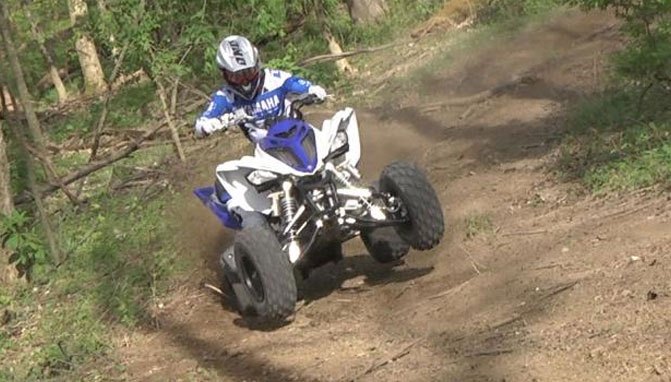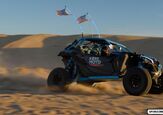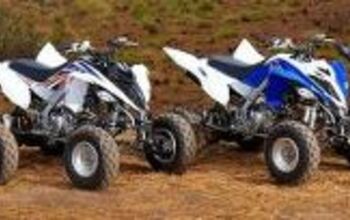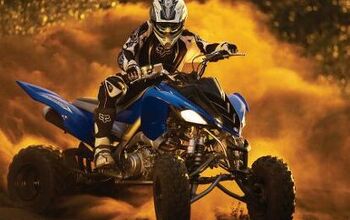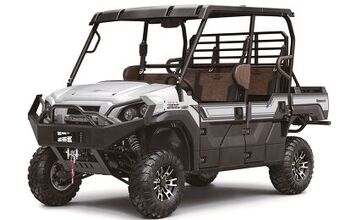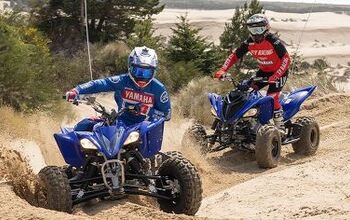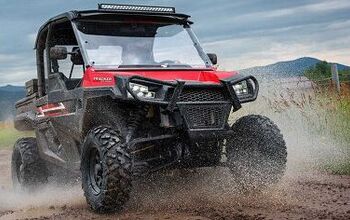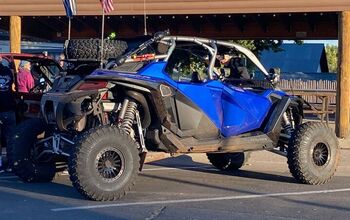2014 Yamaha Raptor 700 Review: Trail Test
On a recent trip to Glamis with the PR crew from Yamaha, we had the chance to put some time on the Raptor 700 in the sand. Its strong torque and broad powerband, plush, mistake-forgiving suspension, and comfortable ergonomics make the Raptor a dune rider’s dream. The 700’s exhilarating performance in the sand left us wanting to explore its capabilities further in other types of terrain.
For our next outing with the Raptor 700, we headed to the wooded trails and meadows of southern Ohio. Our private test location featured fast field trails and lots of hilly areas. One trail section was turned into a wooded motocross track with doubles, tabletops, whoops, G-outs, and lots of elevation changes.
Motoring Down the Trail
With the hair raising throttle response and high-revving nature of modern 450cc machines, the thought of riding a 686cc four-stroke machine on tight, wooded trails might seem kind of ridiculous. Truth be told, the Raptor 700 engine’s broad and smooth power delivery and well-spaced five-speed gear box with reverse are perfectly suited to diverse trail conditions. Strong low end torque, silky clutch engagement, and fuel injection make the engine difficult to stall accelerating from a dead stop. Power delivery off the bottom is ample enough to rip the back tires loose, yet smooth enough that you can easily make the most of available traction on a slippery creek bank or other traction challenged situation.
The Raptor 700’s torque-happy engine and smooth clutch are well suited to the trail.
The Raptor’s head features a high-performance, four-valve, single-overhead-cam design. The piston, crank, and rod are cast, making them lighter to promote throttle response and rev-ability. Acceleration with the 700 is on par with the 450cc class race machines; however, power is delivered in a much more manageable and less fatiguing manner, giving up a little rev-ability for noticeably more ride-ability. You can lug your way out of a slick off-camber corner or blow the berm off a sweeping turn thanks to the Raptor’s potent yet seamless midrange rush. Good torque and a strong midrange-focused engine let you rocket up steep hills with little run at the bottom or put some distance between you and your buddies on lesser sport machines.
COMPARISON: Read our review of the 2014 Yamaha Raptor 700R SE and YFZ450R SE
On tight trails or wide open spaces, we never once hit the rev limiter, which kicks in at 9000 rpm. The big thumper is corked up a bit on top, so you rev the engine through the midrange and grab the next gear for maximum acceleration. As a motor that likes to be short shifted, it should also outlast smaller displacement machines that like to be revved to the moon. The wide ratio five-speed transmission works brilliantly on the trail. First gear is low enough for anything except straight up rock crawling, and first through third will carry you through most corner strewn trails. As the trail opens up, fourth and fifth gear will carry you up over 70 mph. We ran out of space before the Raptor ran out of acceleration! As well, we were pulling wheelies at 40 mph with a handful of gas and a little tug on the bars. Now that’s thrilling!
With acceleration for days, the Raptor 700 makes short work of wide open trails.
We like the ratio of the reverse gear, which pulled well while allowing just enough speed to spin the tires if needed. Our only complaint about the reverse procedure is that you have to remove your hand from the handlebar to engage it. We can imagine situations where we might want to engage reverse without taking our hand off the front brake. A handlebar-mounted reverse lever would make this possible.
The big engine can take a few minutes to get heat circulated and settle down into its normal state of flawless throttle response. The EFI means no need to mess with a choke or re-jet for year round temperatures that can vary from 0 to 100 degrees Fahrenheit where we tested.
Tree Dodging and Creek Jumping
The Raptor’s 45.5-inch width allows it to easily slip through ATV trails, which are typically 50 inches wide on public land. With a front end geometry similar to the original YFZ450, the Raptor 700 feels agile cutting corners in the woods, thanks to its accurate, responsive steering. The Raptor’s front shocks do a good job of preventing body roll. This helps make the 700 feel surprisingly stable in turns. Unlike the old school Raptor 660, the 700 corners pretty flat, helping hide the higher mass of the tall engine and higher mounted fuel tank.
Thanks to its narrow stance, the Raptor carves through tightly wooded areas with ease.
Sometimes having a big engine can work against you – not so with the Raptor. When you start pushing the limits of the Raptor’s stability in turns, you can tuck in, stab the gas to kick the rear end out and powerslide through turns. The machine’s higher center of gravity is a little more noticeable on the trails, due to the additional traction provided by regular dirt. Riding in the dunes doesn’t create as much side load on the machine as it breaks loose and slides more easily. It’s not overly tippy like the old Raptor 660, but it couldn’t quite hang with the motocross-width YFZ450R in the turns. High speed stability is good thanks to the 50.4-inch wheelbase, although the responsive steering feels a bit touchy nearing top speed. The front feels predictably planted on steep hills, yet it can easily be lifted for trail obstacles or prolonged wheelies.
COMPARISON: Read our review of the 2013 Polaris Scrambler XP 850 + Video
The 700R comes with suspension components on par with what’s used in the 450 class. The reservoir-equipped shocks are fully adjustable with threaded preload, high and low speed compression, and rebound damping adjustments. A total of 9.1 inches of suspension travel up front and 10.1 inches of travel out back is more than the 400cc class sport machines and half of the machines in the 450cc class!
Fully adjustable shocks are on par with anything you’d find on a 450cc class machine.
When we first hit the trail, we felt that the ride was a little imbalanced. The first time we got a little air it was immediately apparent that the front shocks weren’t using as much travel as the rear. We backed off four clicks on the front shocks’ low-speed compression damping, putting it in the dead center position 14 clicks out. This small change balanced the ride nicely when cruising over rocks, ruts, and roots on the trail, or when getting some air. The Raptor 700’s suspension strikes a beautiful middle ground in performance. Its action is plusher than most high performance ATVs, while it possesses more bottoming resistance than many others. This is how we felt about its performance with minimal tweaking of the shocks’ stock settings, leaving lots of room to soften or stiffen things up to suit your riding style
The suspension is plush like a sport quad should be, will skip through whoops predictably, hold up under G-outs, and resist bottoming on jump landings like a motocross quad. It’s as close to perfect as any suspension has come for the free-rider who wants to cruise trails one minute, then fly off something huge the next. We’d have to say that the Raptor’s suspension is equally at home on the trail as it was in the dunes, and we wouldn’t hesitate to take it around a motocross track.
The Raptor 700’s suspension is versatile enough for the dunes, trails or even a motocross track.
In 2013 Yamaha added the rolled lips to the aluminum wheels to increase strength and save weight. New Maxxis tires were also added last year, with the purpose of reducing weight and improving performance. The tires didn’t seem to suffer from the high level of body roll often associated with OEM tires. They slid predictably and offered plenty of traction in the dirt. It’s likely that most owners will switch over to a more purpose-specific tire, but the stock Maxxis meats seem to do a good job of providing decent performance no matter where you take them.
The Brakes
The Raptor’s brakes leave nothing to complain about. They offer excellent feel, power, and progression. The adjustable reach front brake lever adds to the ease of operation of the brakes. Now with dual-piston calipers at both ends, the Raptor offers ample stopping power that never seems to fade thanks to drilled rotors at both ends. The brakes’ performance is beautifully matched to the rest of the machine’s performance and size, which will let you late-brake your buddies racing into corners.
Ergonomics and Comfort
A Newbie’s Guide to ATV Riding in Glamis + Video
The cockpit is spacious and well laid out, combined with a well-padded yet relatively flat seat to provide all-day comfort and ease of movement. Charging corners in the dirt requires you to hang farther off the machine than you do in the sand, due to the added traction. We really enjoyed the benefit of the more spacious ergonomics, which were updated in 2013 when the fenders were moved forward 50 mm. The 45 mm pegs are comfortable and provide good footing in the wet, mud, or when landing from jumps. Riders under 5’6″ may find the handlebar a bit of a reach; however, this can easily be remedied with a different handlebar, or with a set of Rox Speed FX pivoting handlebar risers.
Conclusion
Simply put, the Raptor 700 a wildly versatile ATV that is at home just about anywhere you want to ride.
While the legendary two-stroke Yamaha Banshee ruled the dunes, its light switch powerband, rigid suspension, and slower less accurate steering front end design significantly hampered its performance on the trail. The Raptor 700, on the other hand, is a modern day dune dominator that is equally at home on the trail. Its engine is fast enough to make your eyes water, while it’s smooth, tractable power delivery let you conquer technical climbs and obstacles with surprising ease. With 450cc class horsepower and a power curve that rewards short shifting, it’s an engine that should easily outlive a 450 with less maintenance. Agile steering, remarkable suspension, perfect power delivery, left us with a yearning and energy to keep riding. For the trail or the dunes, you can’t go wrong with the Yamaha Raptor 700.
More by ATV.com Staff



